AHMAD JAMAL / “Autumn Leaves”
Today I headed outside for what was supposed to be a quick minute to feel the air and soak in a little sun. Somehow, I ended up on a ride all over town. I'd got myself lost in the architecture of jazz and couldn't figure any way out except to start writing.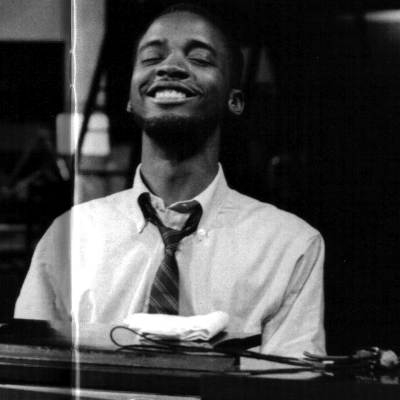
The first stop was the Ahmad Jamal Trio's take on "Autumn Leaves," a tune that I thought I'd already heard done in every conceivable interesting way, culminating in the epochal Miles/Cannonball version from the latter's 1958 Blue Note classic Somethin' Else. But then I heard Vernell Fournier start leaping, striding, skittering, high-stepping and slick-sliding his way around that drum kit and I stopped, like, 'Whoah—that's real.' And if you think Vernell's moving with more agility than Ahmad can handle, you're wrong, because—as I believe Kalamu has told us before—Ahmad just might be the fleetest of finger to ever sit before the black and whites. (Ironically, Ahmad's "Autumn Leaves" dates back to the same year that Miles & Cannonball's does. What's up with that?)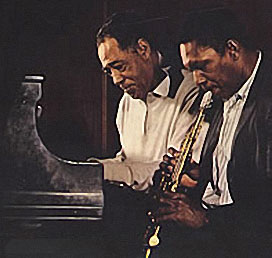
I had to keep moving in a similar vein, and at a similar speed, so I told the driver to head over to John Coltrane & Duke Ellington's "Take The Coltrane" where I found Elvin Jones doing the same hyper-rhythmic drum thing as I'd just seen at my last stop. Not just that, it was Coltrane and leaping and dodging through the drum licks like it was all nothing but child's play. And Ellington. So, so cool: plays what he needs to play and nothing else. Why should he? The cats were having fun - clearly - but it's serious fun. There's an old R&B song (by the Velvelettes - look that one up) named "He Was Really Sayin' Somethin'." Well, like the ladies sang, Trane and Duke are really saying something right here, but they're saying it with a wink. And a grin too.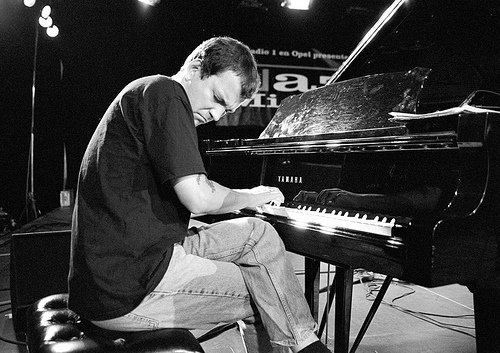
From there, I stayed with the same angular style but slowed down considerably. I hopped out of the ride and took a little stroll through the park. I was listening to my man Brad Mehldau doing an original (I think) named "At A Loss." Here, I was checking for the what Brad (the pianist) and Larry Grenadier (the bassist) were putting together. Jorge Rossy (the drummer) is keeping sweet time (mostly with brushes - although he does take out the sticks midway) but the beams and rafters and joists and angles of this house are Brad's and Larry's to build and they do so with both spirit and grace. (Listen to how Brad breaks into the blues near the end of his solo, but only for about four or five notes. It's like one of those passing pop-culture references I like to hear from modern-day rappers. Just throwing it in there and moving on.)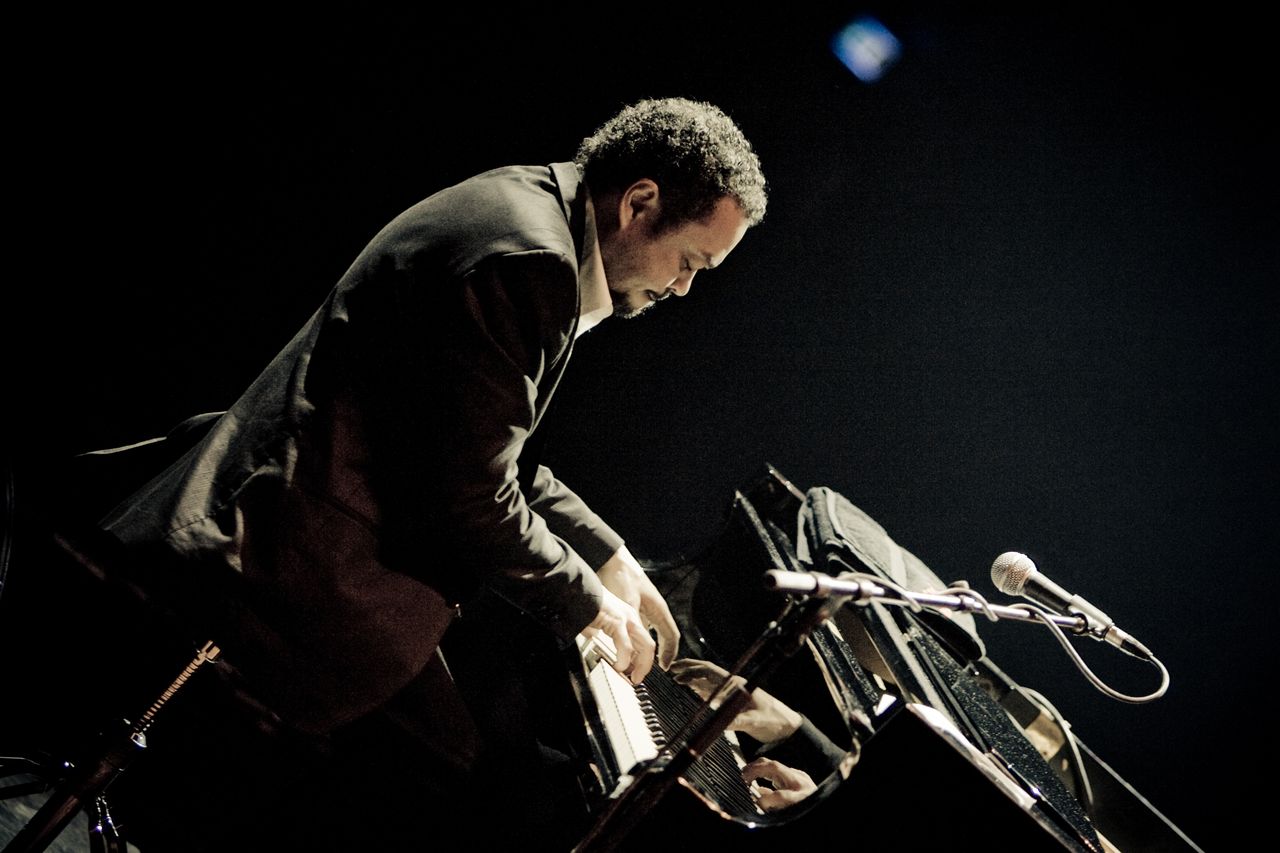
Back in my ride, we turned onto an unfamiliar street where I caught sight of a towering spectacle of orange and yellow and purple - an outlandish-looking, peacock-ish construction that had me tapping the driver on the shoulder, talking 'bout, "Slow down, man! I'm trying to see what's happening over there!" I just laid back and watched for a while but the thing kept on getting prettier. Eventually I had to ask, "Who built that?" The answer came back to me: "Mario Canonge." Didn't mean anything to me. Like I said, I didn't even know where I was. I inquired further: "What'd he build that thing with?" All I got back was a shrug and a murmur: "Some Caribbean shit, I believe." Hmmm. Dig that.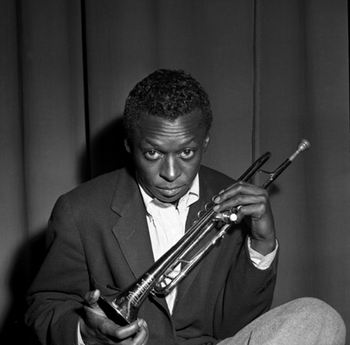
Back in a considerably more familiar neighborhood, I wrapped up my brief jazz excursion with a quick viewing of a little something by my all-time favorite architect of instrumental music—Miles Dewey Davis. We're talking "Footprints" and on this one, the drummer moves back to the fore - then again, this being the young Tony Williams, that could almost go without saying. Tony's constructing all sorts of wild parallels and verticals and leaps and drop-offs, changing the time whenever he feels like it. Miles comes in with a solo that begins lyrical and pensive then turns about as fiery as he ever got in those second-great-quintet years. Tony's still being Tony when Wayne comes in. Or should I say, eeeaaases in. By now (and maybe it's just me) the melodic theme of the tune seems to be long forgotten. Wayne's speaking on issues of the day, or whatever's on his mind, or things that may not have even come to past yet, but I don't really hear "Footprints" except in the briefest of fragments. 6:07—Ha! There it is—Wayne's playing the familiar melody...but then, his solo's over. Herbie comes in: it's clusters and space, clusters and space, and not for very long either, and then all the horns are back—it's "Footprints" again.
Then that was that. I was back at home - back where I started. I tipped the driver, hopped back onto the sidewalk, thanked the music gods for the ride that was and headed on inside. Jazz music, baby.
—Mtume ya Salaam
Historic Preservation Society
The good folk of the Urban New Negro International Jazz Historic Preservation Society ("UNNIJHPS" for short) took Mtume for a quick spin. He’s been on those streets before but this time they pointed out the significance of a few of the houses and even showed him how some of the new abodes interacted with the more established structures.
Sometimes we be passing by stuff for days, sort of taking things for granted, never paying close attention to just how impressive is the usual construction.
Sometimes we need to go on a little guided tour and have someone give us a briefing, someone who's privy to some of the facts and figures. Then, when we are re-looking at some musical facades we’ve glanced at a million times, then all of a sudden, the new information illuminates overlooked facets and “ding!” the little red light bings on in our head, and we say: whoa—I guess I never stopped to appreciate it in that way.
There’s a reason some of this stuff is "classic" and needs to be given its just due. Especially that Ahmad Jamal. That’s a quiet little three story that is easy to zoom pass because it doesn’t tower over everything else but, check it, even over fifty years later there’s a lot that can be learned about swinging in there. Ahmad Jamal was a genius of his times carefully, consistently and insouciantly prefiguring the new directions jazz is still traveling: the melodic vamps over hard-swinging rhythms, the restructuring of the melody into melodic hooks, the importance of individualizing and personalizing an improvised flow.
Once the similarities are pointed out, then we can see, and dig, that these taken for granted constructions comprise a major architectural movement that should be studied and celebrated. Just because it’s accessible to us everyday, doesn’t mean that it’s not extraordinary.
Sometimes it’s good to be reminded of the treasures we forget we got.
—Kalamu ya Salaam
This entry was posted on Monday, April 6th, 2009 at 2:30 am and is filed under Classic. You can follow any responses to this entry through the RSS 2.0 feed. You can leave a response, or trackback from your own site.
Leave a Reply
| top |